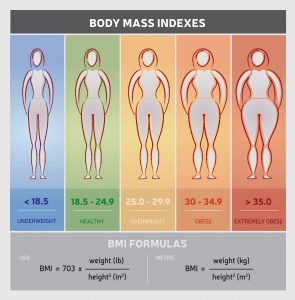This post is part of the series weight
Other posts in this series:
- Let’s talk about the value of ideal weight (Current)
- Let’s talk about weight- why are we so fat?
- Diets do not work

Ideal weight is such a sensitive issue. In my practice, almost every woman and many of the men are unhappy with their weight. I often wonder what it would be like if every person in the world woke up one day, happy with how they looked. I think a lot of diet and beauty industries would go bankrupt!
What is “ideal weight”? Surprisingly, this concept is not that easy to define. First off, there seems to be a paradox in patients’ awareness. Next, doctors can not seem to agree as to what it is and how best to measure it.
The patients who should be worrying about their weight, seem not to. The anorexics feel happier and more in control the more their weight falls off, despite falling over from weakness. The morbidly obese feel that they have “tried everything” to lose a bit of weight.
The most obvious measurement of weight is the number on the scale. It is an unreliable measurement because it simply reflects the combined weight of all our body’s tissues and fluids. Our weight can vary considerably at different times. We weigh less in the mornings than in the evenings. Premenstrually a woman’s weight goes right up. The flu can make us lose a bit of weight. Hydration levels affect the reading. The best way to deal with a scale weigh-in would be to weigh at the same time, once a week and then to look at the trends over time, as opposed to having our spirits crushed by a once off high reading the morning after a pizza meal. I have patients that have such a litany of abuse released in their heads by a slightly high scale reading: “you are a fat slob”, “you have no self-control”. The power we give to that one reading can be petrifying.
The power we give to that one scale reading can be petrifying
Science has come up with the optimal weight range of BMI (Body Mass Index). It is measured by taking your weight in kilograms and dividing it by your height squared. All very scientific. Normal body weight is considered 18-25. Under 18 you are considered underweight, with increased risk for poor immunity, fertility issues, weak bones and chronic fatigue. Over 25 you are classified as overweight.

BMI as a health measure has quite rightly come under a lot of criticism, largely because it wasn’t designed for you, the individual. It was designed to look at broad trends within large groups- to assess if there is an obesity epidemic within a population. It was not designed to make allowances for the relative proportions of bone, muscle and fat in the body. Bone is denser than muscle and twice as dense as fat, so an athlete with strong bones and good muscles might be classified as overweight even though they have little fat on them.
Doctors nowadays tend to do an abdominal circumference too. More than 80cm for women or 90cm for men is considered overweight. This is probably a medically sensible measurement, because your visceral fat – the fat around your abdominal organs – is more of a trouble maker for your health than fat sitting elsewhere, like on your hips. Its biggest problem is that the measurement of it hasn’t been standardised. Some recommendations are for over the iliac crests (the boney part of your hips), others are for the narrowest part of the waist (just under your ribs). That’s why your clinic nurse and your doctor can get two completely different readings. Clearly, your measurement will be better after you toned up in a workout than the day before your period.
With these considerations in mind, it should be clear that your ideal weight can’t really be a number. These readings should not become dogma to obsess over. But it is also important to be honest with oneself. If you are buying bigger clothes each season, if your knees ache with a bit of exertion and you can’t see your toes, it’s pointless trying to kid yourself that you are a bit chubby. Maybe we should trust “strong and healthy” as the new sufficient.
References:
- “Why BMI is inaccurate and misleading” Medical News Today, Aug 2013, Christian Nordqvist
- “Evaluating and measuring body composition” American College of Sport’s Medicine, Oct 2016, Tiffany Esmat
Continue reading this series:
Let’s talk about weight- why are we so fat?








2 Comments
Hi Mars. Nice piece. Interestingly this very topic came up on our ward round yesterday. Surprisingly having a ‘normal’ BMI is associated with a higher mortality than having a BMI in the range 25-30 and especially so when the body comes under a stress for example being in an MVA and ending up in ICU. Clearly we don’t have one good reliable reproducible and easy way to to really assess body ideals for health at this stage
That is interesting Michelle, thanks for that. The old grandmas also preferred chubby babies, feeling that they better survived infancy. We really don’t have a good way to define body ideals